| Share |  |
 | |||
Sugar Bondage - How You Can Be Free - Part One
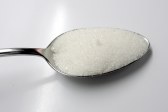 Sugar does more to upset body chemistry and contribute to the breakdown of health than any other consumed substance.. No one wants to hear that something that tastes so good is indeed so bad for us, for who doesn't love sweet things to eat? While I am not suggesting that you remove all "sweetness" from your diets, I would like to challenge you to understand what the wrong kinds of sugar actually do to the organs, tissues and cells of the body so that you might be motivated to become free from their harmful effects.
Sugar does more to upset body chemistry and contribute to the breakdown of health than any other consumed substance.. No one wants to hear that something that tastes so good is indeed so bad for us, for who doesn't love sweet things to eat? While I am not suggesting that you remove all "sweetness" from your diets, I would like to challenge you to understand what the wrong kinds of sugar actually do to the organs, tissues and cells of the body so that you might be motivated to become free from their harmful effects.
The Cause and Effect Relationship of Sugar and Disease
An undisputable correlation exists between increased consumption of refined sugar and carbohydrates in the standard American diet and the alarming increase in metabolic and chronic degenerative diseases people are experiencing today. New cases of  diabetes have increased by 90% in the last decade and it is believed that as much as a third of all Americans are pre-diabetic. It is also estimated that one third of all children born since 2003 will develop diabetes in their lifetime and that this same generation of children will be the first to live shorter lifespans than their parents. Already, many children and young people are developing Type II diabetes, previously considered a disease only experienced by adults.
diabetes have increased by 90% in the last decade and it is believed that as much as a third of all Americans are pre-diabetic. It is also estimated that one third of all children born since 2003 will develop diabetes in their lifetime and that this same generation of children will be the first to live shorter lifespans than their parents. Already, many children and young people are developing Type II diabetes, previously considered a disease only experienced by adults.
Two thirds of the U.S. population is either overweight or obese. According to the Center for Disease Control and Prevention, obesity rates have doubled in adults and tripled in children and adolescents over the last two decades. Obesity-related disease is now second only to smoking as the leading cause of preventable death. Despite the decline of dietary fat stemming from people eating more low fat foods in the last few decades, the rate of obesity and associated health problems has risen in proportion with the increased intake of refined sugar and carbohydrates . Many of the chronic degenerative diseases people suffer from today are either caused by or linked to out-of-control blood sugar and insulin levels in the body. These types of conditions were never found in societies where refined sugar and carbohydrates did not exist.
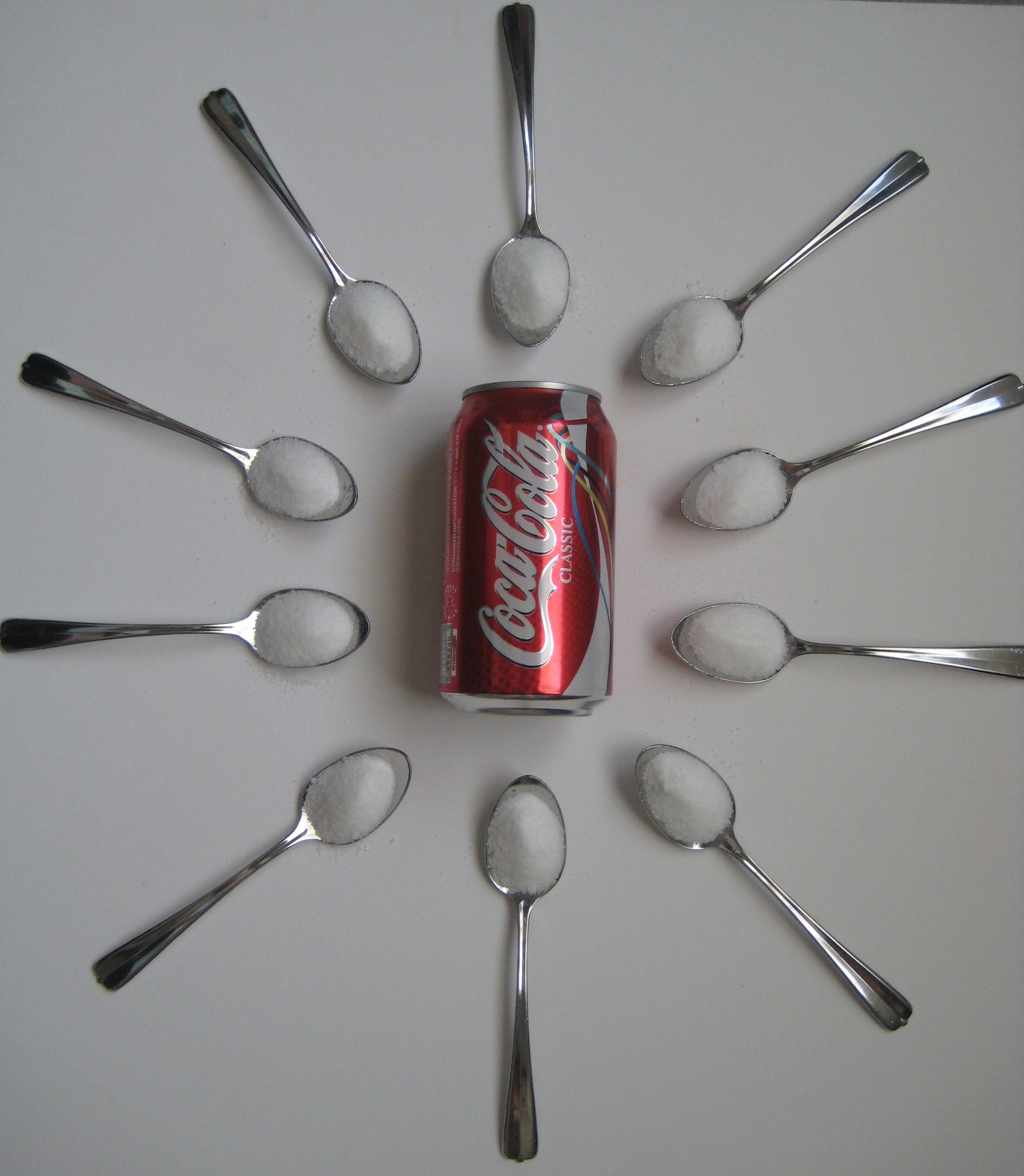
How Much Do We Really Consume?
The amount of sugar Americans are consuming in their diets has increased 1500 percent in the last 200 years. In the 1880s, the average consumption was about five pounds per person per year. The highest recorded consumption was in 1999 at 151 pounds per person per year, according to the USDA. It has now declined to approximately 142 pounds per person per year, which equals approximately 48 teaspoons or 1/2 cup of sugar per day. The 2005 Dietary Guidelines for Americans developed by the USDA and HHS (updated every five years), recommend no more than eight teaspoons per day of added sugar based on a 2,000 calorie daily diet. Actually, the average healthy digestive system can only handle about four teaspoons daily without noticeable problems, so even that amount is high for optimal health The body actually only needs about two teaspoons of blood sugar at any one time in order to function properly and this amount can easily be obtained from the breakdown of unrefined carbohydrates, proteins and fats.
Soft drinks and other beverages contribute the largest number of calories, with an average of 10 teaspoons of sugar in a typical 12-ounce can of soda. Sugar coated breakfast cereals and sweet desserts follow close behind. Even most fruit juices contain high fructose corn syrup and those advertised as 100% juice are made sweeter by adding the concentrated juice of other fruits that are particularly high in sugar. When we think about how much sugar people consume, we tend to think only of white table sugar contained in baked goods or added to coffee or tea and never would imagine it adds up to these levels of consumption. This seems true until we realize how many different forms of sugar there are and how many products have hidden sugars, especially high fructose corn syrup.
Just Read the Fine Print
Sugar is America’s number one food additive, with ten times the consumption rate of any other food additive. Unless you are eating an all-natural diet and avoiding most processed foods, it is likely you are consuming more sugar than you realize, 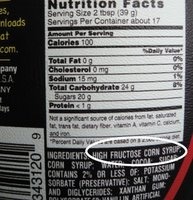 because 90% of processed foods contain sugar whether or not it is what would considered to be a “sweet.” item. Even choices people would consider “healthy,” such as low-fat processed foods, that have been so popular in recent decades, contain sugars added to replace flavor lost from fat removal. A typical small carton of low-fat, fruit-flavored yogurt, for example, has seven teaspoons of sugar. It is not surprising that people fail to lose weight while eating these low-fat foods, since the added sugar content results in the consumption of the same number of, if not more calories than the higher-fat varieties.
because 90% of processed foods contain sugar whether or not it is what would considered to be a “sweet.” item. Even choices people would consider “healthy,” such as low-fat processed foods, that have been so popular in recent decades, contain sugars added to replace flavor lost from fat removal. A typical small carton of low-fat, fruit-flavored yogurt, for example, has seven teaspoons of sugar. It is not surprising that people fail to lose weight while eating these low-fat foods, since the added sugar content results in the consumption of the same number of, if not more calories than the higher-fat varieties.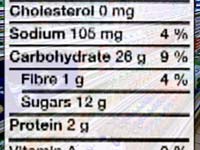
The only way to know what you are consuming and to avoid these hidden sugars is to familiarize yourself with the names of the various types of natural and manufactured sugars and become an avid label reader. You will be amazed at the number of foods not even considered very sweet that contain various added sugars. For instance, certain brands of 100% whole-wheat crackers that most people would consider a healthy food choice contain four or five different forms of sugar, including high fructose corn syrup. It’s hard to find granola bars, even “healthy” ones with nuts and trail mix, that don’t have at least six types of sugars in them. And then there is ketchup, which contains a full teaspoon of sugar in every tablespoon!
Normally, you can tell the relative amount of an ingredient in a product by how close it is to the top of the ingredient list, but that doesn't work when various types of sugars are used in one product, as is so often the case. Though the different forms of sugar are used in smaller amounts and may not be as noticeable further down the ingredient list, adding the total sugar content together could easily mean that sugar is the number one or two ingredient. A typical cereal may not have sugar in the top three ingredients, but further down the list you will find sugar, brown sugar, corn syrup solids, honey and maltose, all in one cereal.
Here are just some of the many names you will find on ingredient labels that indicate the presence of sugar:
| Sucrose | Sorghum |
High Frutose Corn syrup |
Corn sweetener | Fructose |
| Maltose | Molasses | Brown Rice Syrup | Maltodextrin | Raw sugar |
| Dextrose | Honey | Cane Syrup | Dextrin | Brown sugar |
| Galactose | Maple syrup | Malt Syrup | Xylose | Turbinado |
| Lactose | Beet sugar | Evaporated cane juice | Glycerides | Invert Sugar |
| Mannitol | Date sugar | Concentrated fruit juice | Raisin syrup | Florida Crystals |
Types of Sugars
Sugars or saccharides are the building blocks of the category of food known as carbohydrates, known for providing the body with quick energy. They occur naturally in foods, such as fructose in fruits and lactose in milk or yogurt. Monosaccharide is the term referring to simple sugars comprised of a single sugar molecule such as glucose, fructose and galactose.
When two simple sugars are joined by a chemical bond, they are called disaccharides. Sucrose or table sugar is a prime example, as it is co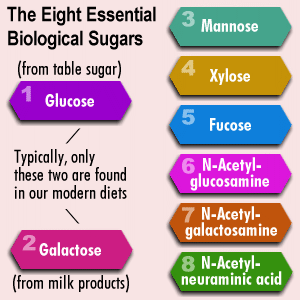 mprised of equal parts of two simple sugars, fructose and glucose. Lactose, another disaccharide referred to as milk sugar, is composed of glucose and galactose. Maltose is a disaccharide that results from the breakdown of starch. It is composed of two glucose molecules and is one third as sweet as sucrose.
mprised of equal parts of two simple sugars, fructose and glucose. Lactose, another disaccharide referred to as milk sugar, is composed of glucose and galactose. Maltose is a disaccharide that results from the breakdown of starch. It is composed of two glucose molecules and is one third as sweet as sucrose.
Carbohydrates comprised of more than two simple sugars joined together are referred to as polysaccharides. Polysaccharides are complex carbohydrates made up of chains of glucose molecules. They include starch, cellulose, pectin and glycogen, the latter being a special form of glucose that is stored in humans and animals. These multiple saccharide bonds break down much more slowly than simple sugars that go directly into the bloodstream. The slower release keeps blood sugar levels more stable and produces energy at a steadier pace. They also offer needed dietary fiber and create a feeling of satiety (fullness) that lasts for hours. All of your fruits and vegetables, whole grain bread, pasta or cereals, and brown rice are examples of complex carbohydrates.
Not all sugars are bad. Just as the right kind of fats in the right amounts play a key role in the optimal functioning of the body—the same may be said about sugar. In fact, there are actually eight sugars found naturally in fruits, vegetables, herbs, milk and other foods that have been identified as essential to human health. These "glyconutrients" (nutrients derived from natural sugars) enhance functions in the body involving the immune, brain and nervous systems as well as provide support for intestinal health, tissue repair and other critical functions. Glucose is the key glyconutrient that is absorbed by the small intestine and circulated throughout the body where it is utilized by virtually every cell. Most of the body's cells require glucose for energy production. The brain and nervous system, in particular, can only function when glucose levels in the blood remain above a certain level.
Refined Sugar Equals Lost Nutrients
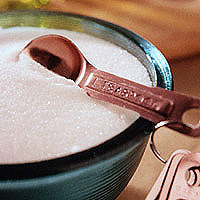 White refined sugar contains 99.9 percent sucrose, extracted from sugar beets or sugar cane. As is often the case, man takes what God made and alters it through many artificial processes, resulting in a denatured substance void of nutritional value. More than 60 different food elements are destroyed during the refining process of sugar. Refined sugar is not even a food; rather it is a pure chemical extract containing only empty calories in place of the fiber, minerals, vitamins, proteins, enzymes and other elements originally contained in the plant source. Its chemical formula closely resembles that of cocaine and it is every bit as addictive in how it works in the body.
White refined sugar contains 99.9 percent sucrose, extracted from sugar beets or sugar cane. As is often the case, man takes what God made and alters it through many artificial processes, resulting in a denatured substance void of nutritional value. More than 60 different food elements are destroyed during the refining process of sugar. Refined sugar is not even a food; rather it is a pure chemical extract containing only empty calories in place of the fiber, minerals, vitamins, proteins, enzymes and other elements originally contained in the plant source. Its chemical formula closely resembles that of cocaine and it is every bit as addictive in how it works in the body.
Not only does sucrose lack nutrients, but it actually causes vital nutrients to be robbed from healthy cells when it is consumed. As the body attempts to metabolize this non-food by depleting its stores of vitamins, minerals and enzymes, nutritional imbalances and a weakened immune system result. Those remains of the sucrose which, despite all the efforts of the body, are not properly metabolized end up accumulating in various cells as toxic wastes and must be removed. All of these factors can lead to the development of various health conditions that will be discussed in more detail in part two of this article.
Refined white sugar is known by many names, including sucrose, table sugar, cane sugar, beet sugar, grape sugar, refined sugar, or granulated sugar. Other types of sugar produced from the refining process of sucrose that have varying levels of sucrose are brown sugar, maple sugar, raw sugar (refined versions go by the names of “turbinado”, “demerera,” or “muscavado), confectionary sugar and molasses. All of these sugars have high levels of sucrose though molasses (the brownish liquid residue left after heat crystallization of sucrose) has the least amount in addition to having the most remaining nutrients after the refining process.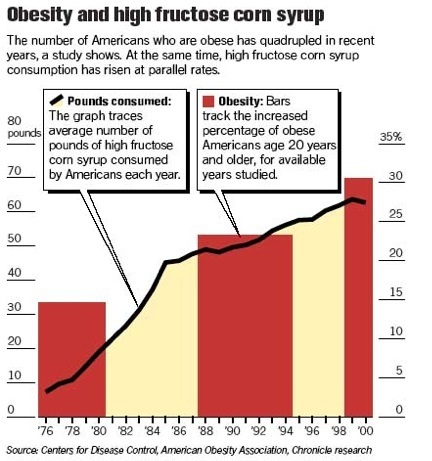 High Fructose Corn Syrup
High Fructose Corn Syrup
Most sugar came from sugar beets and sugar cane in the form of sucrose prior to 1970. It was after that time that a detrimental shift in the American diet occurred, when high fructose corn syrup (HFCS) was found to not only extend shelf life but also be much sweeter and less expensive to produce (the U.S. government subsidizes corn!). HFCS is found in abundance in sodas and fruit-flavored drinks and has taken the place of sugar in the great majority of processed foods. It is contained in commonly consumed items such as breads, crackers, cereals, breakfast bars, lunchmeats, salad dressings, yogurts, canned fruits, soups, condiments and many fast food items. The USDA estimates that the average American consumes 17 teaspoons of HFCS every day. Just one two-liter bottle of soda contains an estimated 15 teaspoons of HFCS. It is interesting to note that the rate of consumption of soft drinks containing high-fructose corn syrup has risen parallel with the rate of obesity, which is now at epidemic proportions in the United States.
High fructose corn syrup is produced by first processing cornstarch into glucose using genetically modified enzymes. The resulting liquid corn syrup is further processed to change more than half the glucose into fructose. When fructose is found naturally in fruits, honey and root vegetables, it is connected to another sugar molecule, which causes it to break down more slowly than sucrose, which is better for the body.

However the artificially manufactured version of fructose in HFCS (high fructose corn syrup) is not attached to another sugar molecule, therefore, it is "free" and more immediately available because it is not bound up in sucrose. In its intensified liquid form, it breaks down very quickly, bypassing the early steps of glucose metabolism.
However, unlike glucose, which can be easily metabolized into blood glucose by every cell in the body, fructose can only be metabolized in the liver. When the liver is fed large amounts of fructose, it can develop fatty depostis and cirrhosis, similar to problems that develop in the livers of alcoholics. And because fructose does not stimulate insulin or leptin production, which help regulate blood sugar and appetite, those who consume it cannot tell whether they are full or not and, consequently, become hungry again more quickly.
Fructose also fails to suppress the hormone ghrelin that works to increase hunger, another contributing factor to the suspected link between increased HFCS consumption and increased obesity over the last 30 years. Also, studies in both rats and humans have demonstrated that fructose converts more readily than glucose into triglycerides and fat tissue formation.
Concluding ThoughtsBoth refined sugars and high fructose corn syrup have many more detrimental effects on the health of the body than have been touched on in this article. It is so important to understand just what goes on inside your body at a cellular level when these types of sugars are consumed. Why? Because you can actually control the state of your health by controlling your blood sugar levels! In next month’s health article, we will more closely examine just how various health conditions related to sugar consumption develop. Then we can learn not only how to be free from sugar cravings and addiction, but also how to be satisfied with the natural sweetness and sweeteners God has provided for our enjoyment and well-being.
Copyright © 2008-2015 Lucinda Bedogne, CNHP, CNC
Post Your Comment...
|
|
||||||||||||



